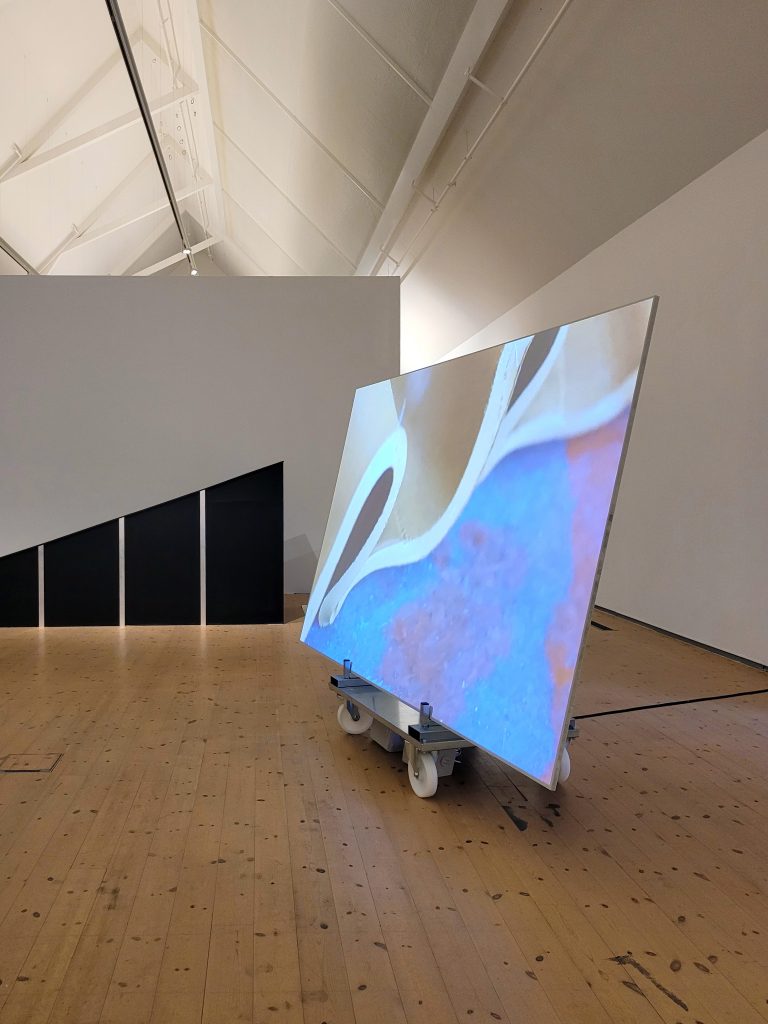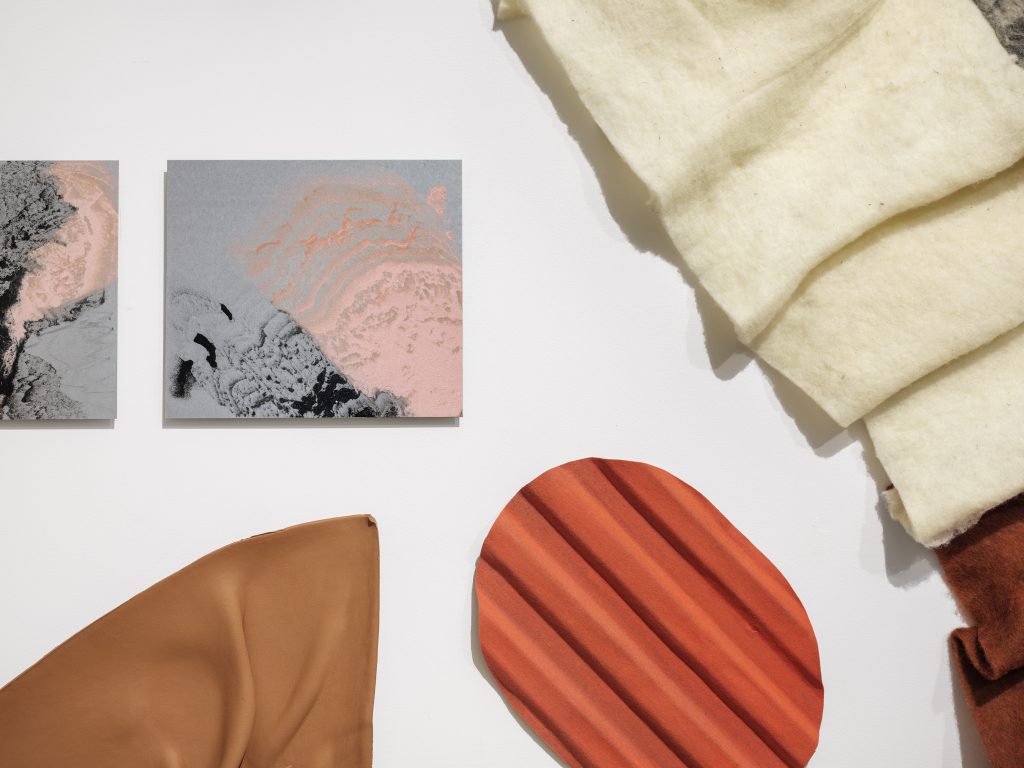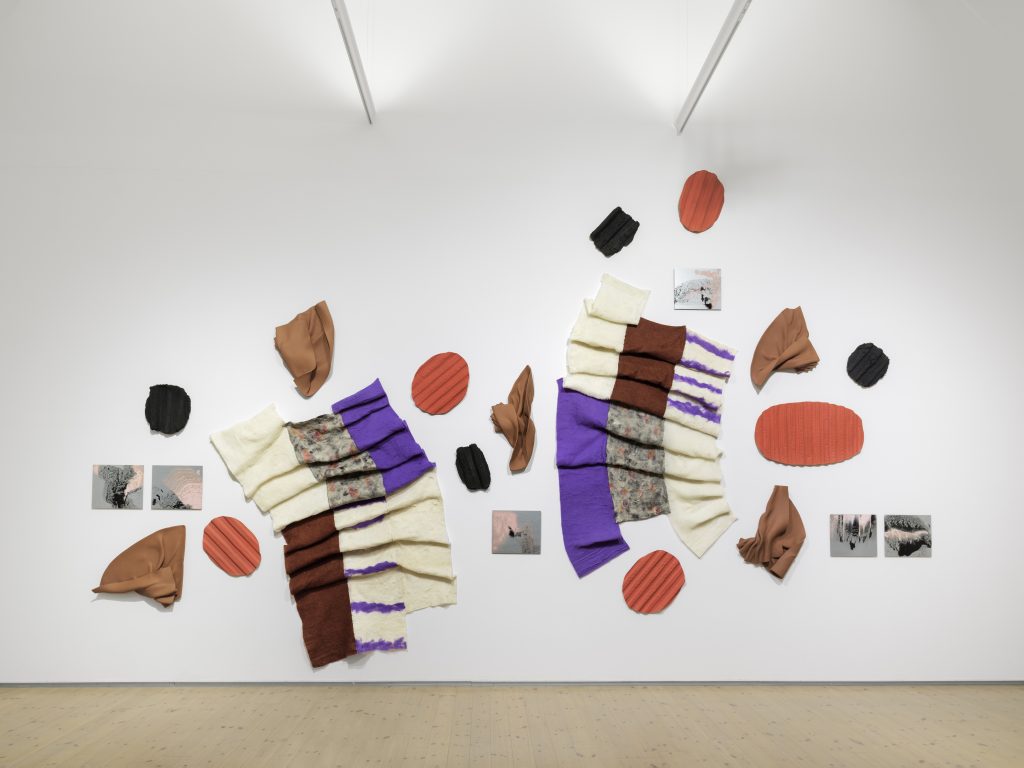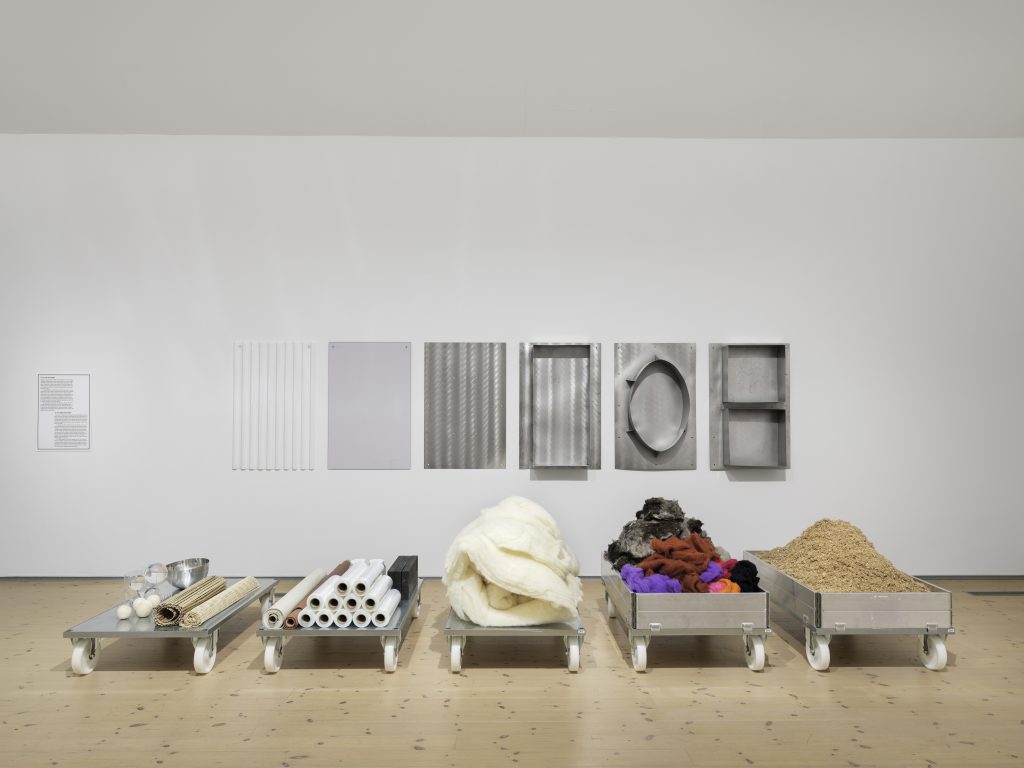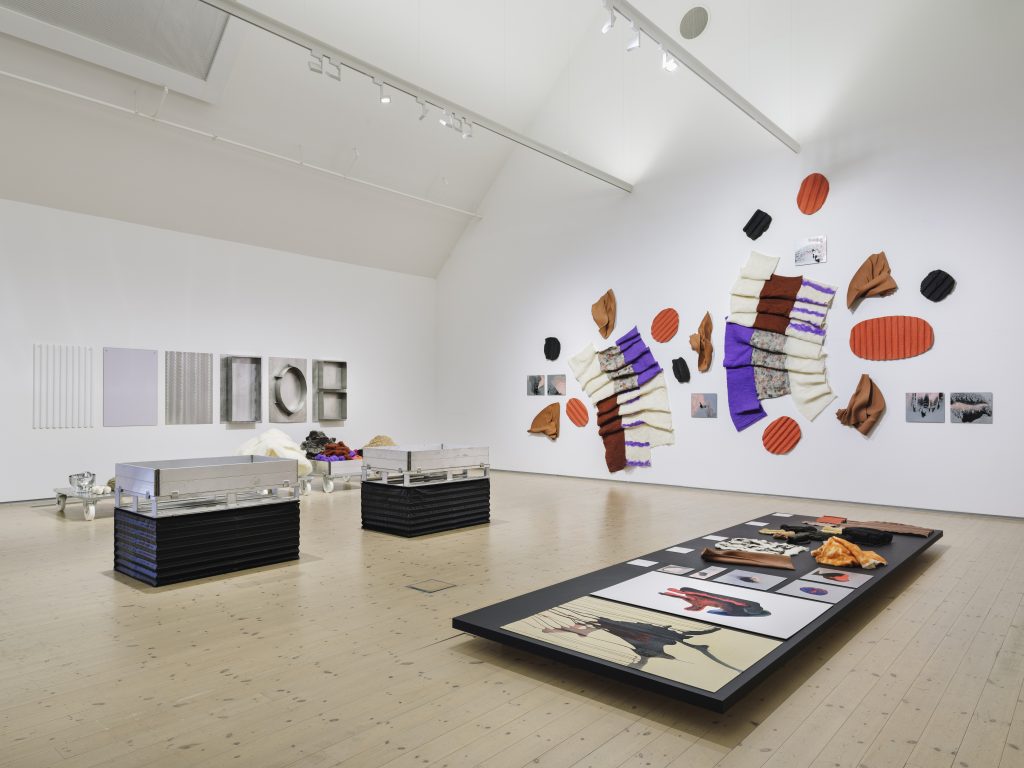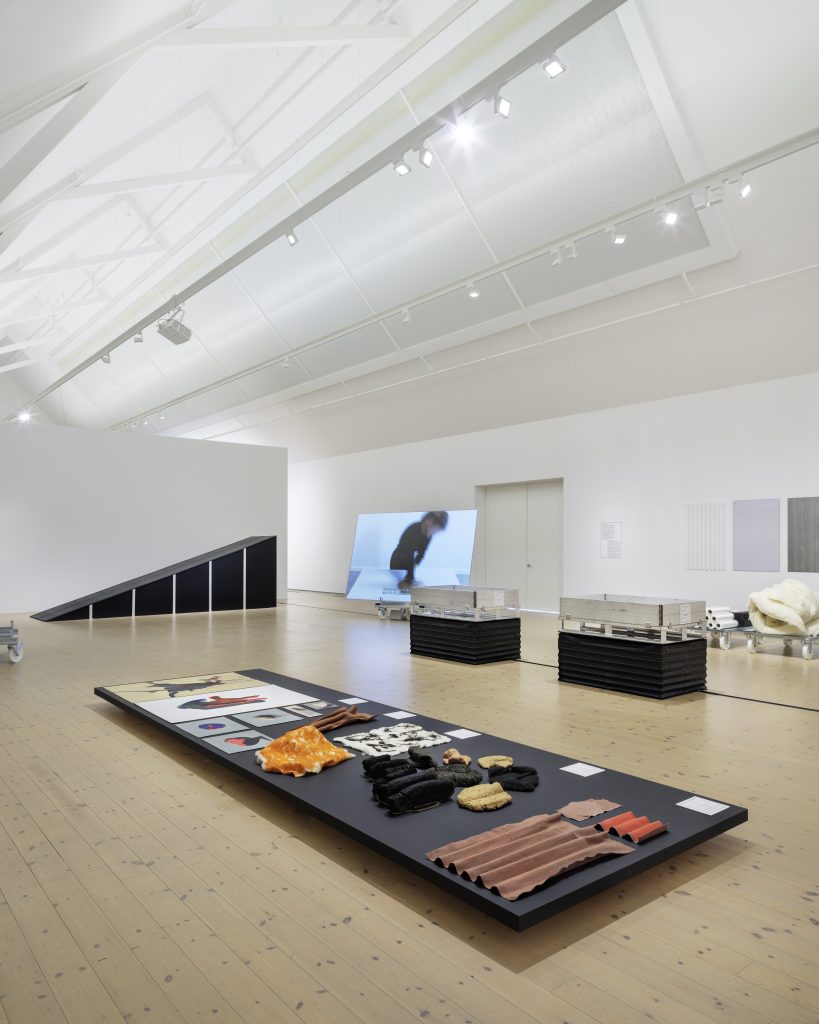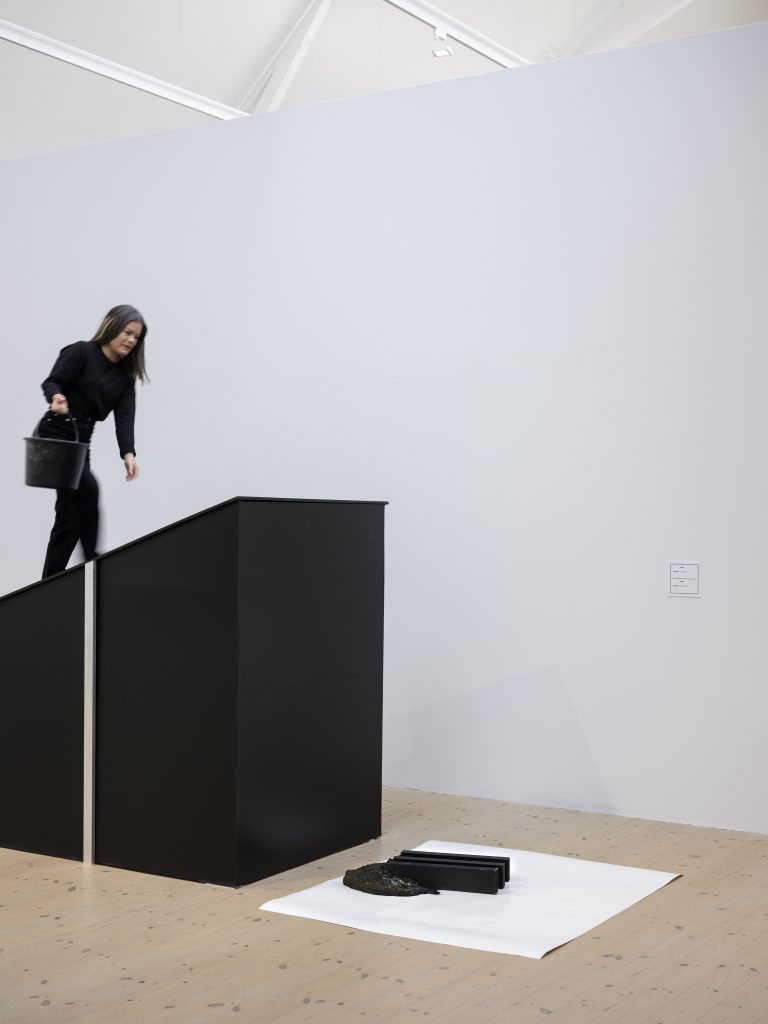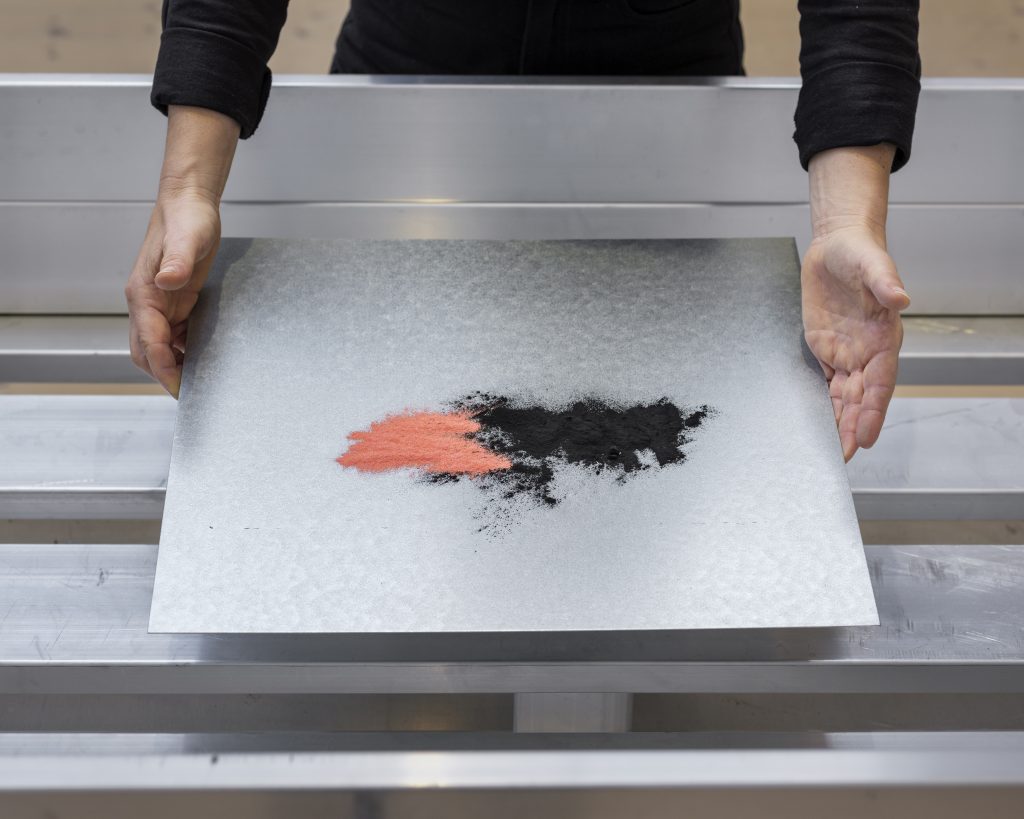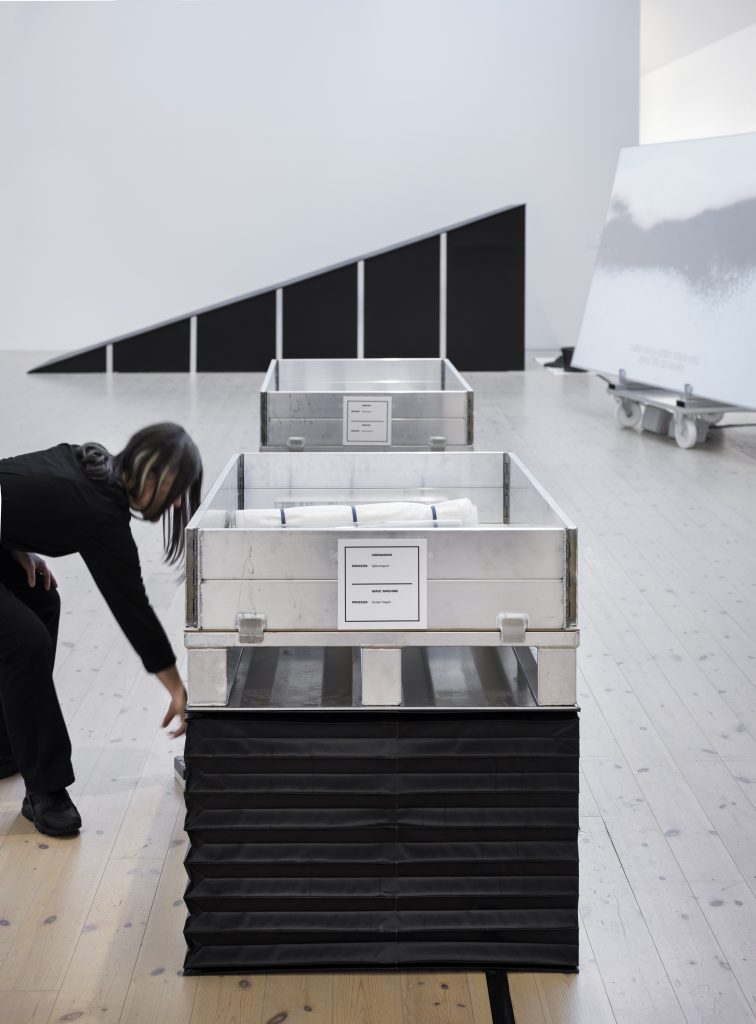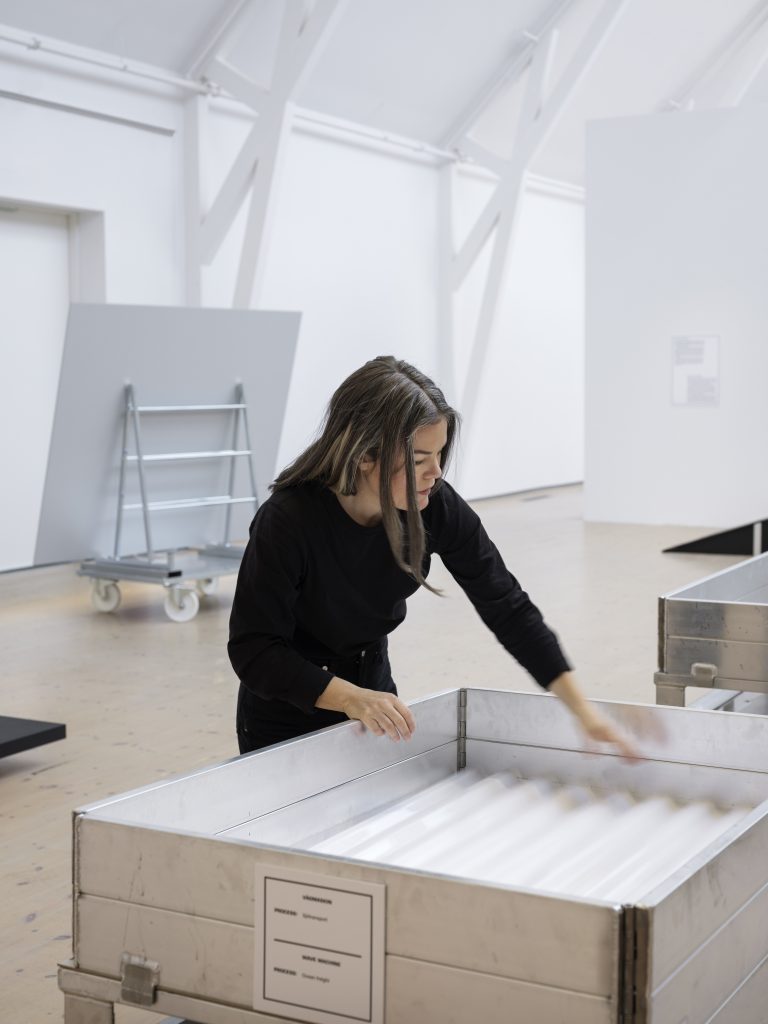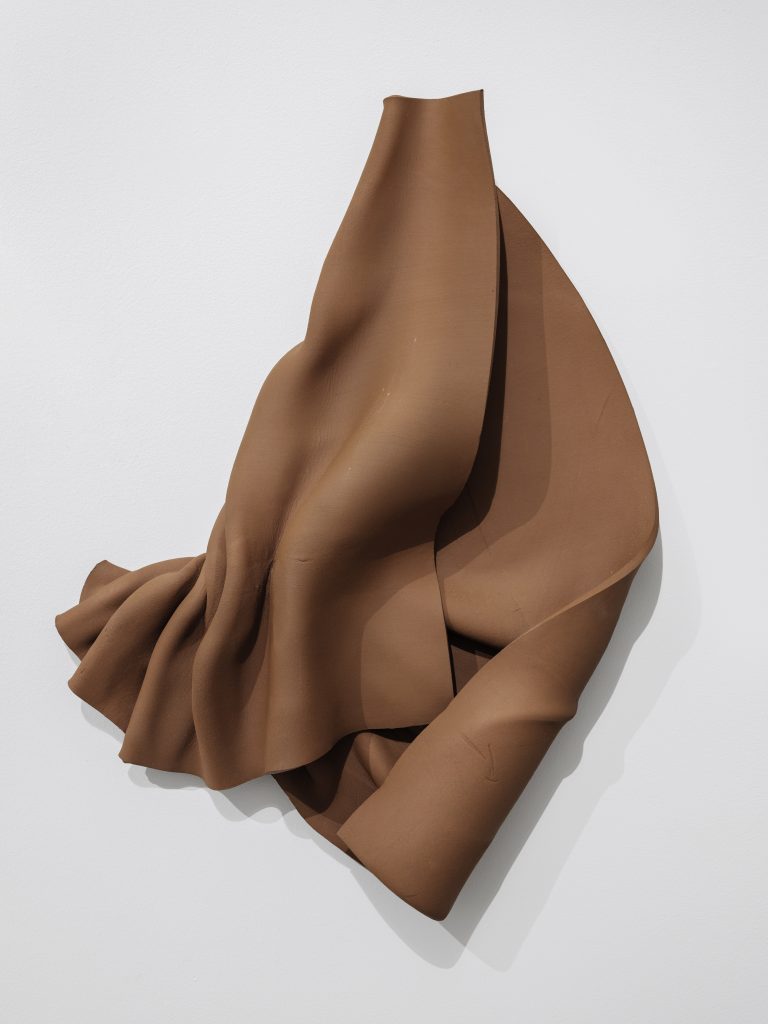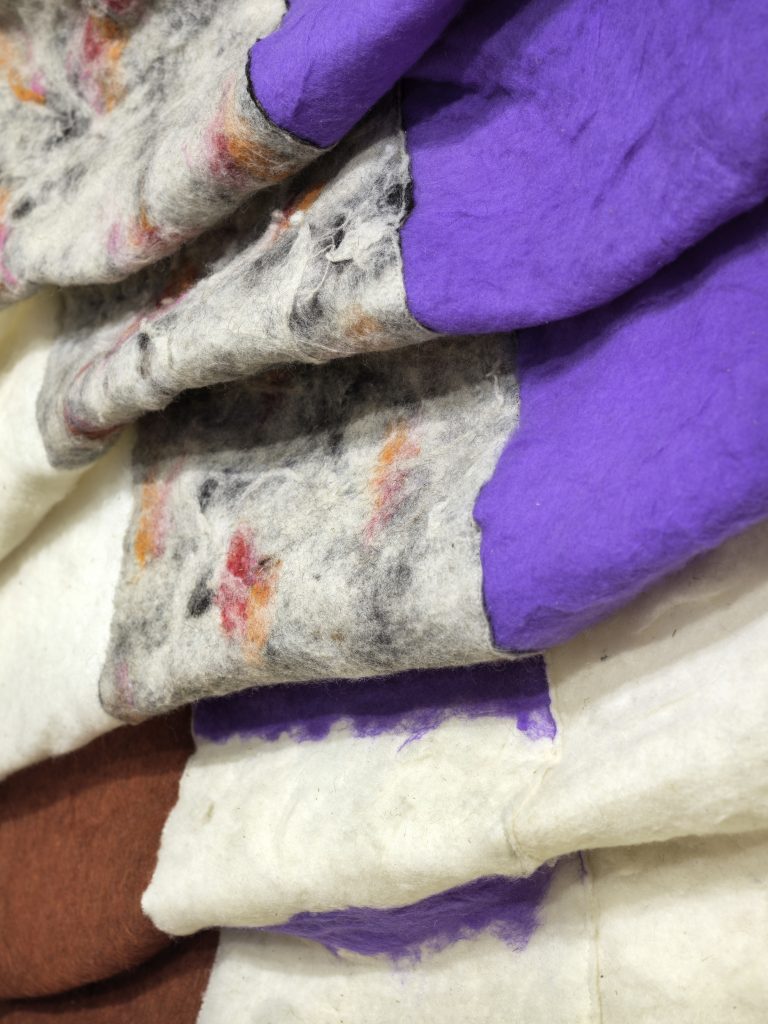-
Active Cargo
Text by Henriette Noermark
“Transport is absolutely crucial to the machinery of global production, but, given that it still makes huge use of fossil fuels, it is also one of the most problematic elements. During the pandemic, we saw what happens when transport does not work. We have become totally dependent on it.”
When the 400-metre-long container ship Ever Given got stuck in in the Suez Canal in the mid of the pandemic, it became all too clear that the world’s infrastructure is suffering from our ever-increasing need to transport goods from east to west and south to north. Moreover, when Russian forces invaded Ukraine at the beginning of this year, it was not just a tragic military and human catastrophe, but also a reminder of the vulnerability of the vast machinery of global production.
An apt subtitle for Active Cargo – the Swedish designer Jenny Nordberg’s solo exhibition at Vandalorum – might be: ”New shapes and forms made by activating materials by the movement within transport resulting in objects.” Since graduating as an industrial designer in 2005 and plunging into a world of mass production, she has been questioning the system and machinery of production to which society clings. Regarding them as problematic and holistically untenable — we must be able to find alternative solutions. She believes in local production and in the intrinsic potential of design to develop in its vicinity.
For decades we have been talking about the existential problem, which increased freight transport – whether by land, sea or air – creates for the climate and environment. This is the messy Gordian knot that threatens our society, and we have not yet been able to resolve it either politically or structurally. We talk about it. Companies shout about it, greenwashing their ambition to work globally, yet sustainably – at some point in the future. One of the UN’s Sustainable Development Goals (SDGs) is ”Industry, Innovation and Infrastructure”, composed of subsidiary goals for ensuring longer-term results by 2030. They include making industry more sustainable, efficient use of resources and increasing clean, environmentally-friendly technologies and industrial processes. Meanwhile, according to Eurostats’ publication Globalisation Patterns in EU Trade and Investment, international transport figures are still rising steadily and the system is being optimised, making short deliveries and dropshipping the only solutions.
If we cannot prevent transport, perhaps we should take a different approach and look at the possibility of reducing the wasted time and energy? This is certainly what Nordberg believes. She is one of the designers sounding the alarm and not accepting any more excuses. After all, what are the arguments for doing nothing? Will we not gain something far more important if we turn our backs on low prices and fast deliveries? Are not close links and proximity to local production worth more than crossing endless national borders? Is it not time to change those structures we have endorsed for years as the only acceptable ones, with the excuse that things have always been done that way?
Nordberg’s call for action is reflected in her exhibition Active Cargo. She looks at whether we can transform passive resources into active ones by using the physical movements, which occur during the transport of products and objects, as potential production devices in themselves. “I want to make the passive active. When an object is shipped, it moves geographically, but the object itself does not utilise that movement or energy. During transport, it is totally passive,” she says, and questions whether continuing like this is not a pure waste of energy and downright inefficient. She compares it to going to work without working. In physical terms, she presents two machines and a five-metre-long ramp, each imitating their own movement during transport. The vibrations, which reflect the bumping of lorries on roads, waves from the ships and falls, which aim to reflect the many accidents that happen with lost packages. In other words, she removes the geographical dimension of transport, but retains the hypothetical movement. Local materials such as clay, bioplastics, wood powder and biodynamic glue pass through the machines and are turned into objects. The movement of transport becomes the actual machinery of production. Conceptually, she looks at the familiar Euro-pallets with frames, which she optimises with black details, and Perspex and glass elements. She cannot predict how the objects will turn out. Some of them are made in situ during the run of the exhibition, so there is a large element of chance and risk. But she is well versed in welcoming serendipity.
“I often deploy coincidences in my work. When it comes to aesthetics, I regard them as co-creators. There are certain decisions I don’t have to make, since coincidences or pre-established standard goals decide the aesthetics and what happens, happens. By relinquishing control, things can happen within a strictly controlled set-up. I love that way of working.”
Active Cargo is a natural successor to Nordberg’s previous projects. I have previously referred to her as “the designer who feels free.” What I meant was that she does not acknowledge limitations as other designers might, but feels free of restrictions and conventions. She takes an analytical approach and does not stop until she has resolved the situation. She approaches the world as an equation to solve. As a political being, she not only observes, but also engages and wants to change the world for the better. Rather than being naïve about, or blind to the potential of speed in mass production, she sees it as an artistic and conceptual hurdle for figuring out how she can use some of the same techniques in her own studio in Skåne and the local community.
In previous projects such as 3-5 sec and 3-5 min (presented at Vandalorum in 2015), she investigated the quality of the rate at which objects are produced. The same was true when she created hundreds of trays for the Vandalorum restaurant, made in collaboration with Åry Trays in Småland. First she painted the birch veneer directly, using a screwdriver and floor mop. The wood was then pressed into trays at the factory. The combination of Nordberg’s unique touch and the manufacturer’s input spotlighted how mass production does not necessarily negate uniqueness.
The local aspect is important. After all, why not make use of the carpenter, glassblower, ceramist or steelworks around the corner and who can keep a close eye on the process? For the exhibition Den Nya Kartan [The New Map] (2015–17), Nordberg paired a number of designers and producers from Skåne, Småland and Halland. The goal was to create products locally. Quality was paramount, and the project involved devising long-term sustainable strategies.
We need to find resources locally, and produce in our own locality, as opposed to subjecting ourselves to a system of capitalist values that involves millions of containers on the water and equally many lorries on roads throughout Europe. What she opposes is the capitalist, consumer mindset, which forms the basis of the way we operate and to which we have become accustomed. We demand fast delivery, optimal quality and low prices. However, when we order furniture, clothes and homeware from different parts of the world, we are becoming more and more aware of the price we pay in terms of climate, environment and sustainability. So, Active Cargo is an extension of her previous work: a design project that essentially sets out to solve a tangible, relatable and crucial societal and climatic problem. The project tackles the necessary changes, which we as a population, consumers and manufacturers need to make, if we are to continue moving around the globe.
When asked what role humour plays for her, Nordberg answers: “It’s probably one of my main purposes in life.” This positive approach clearly informs all of her work. It is not to be confused with superficiality. But smiling is invaluable when you are working with something as existential and significant as design. “I’m interested in communication and know that humour is a great way to pose serious questions,” she says. It is not simply a way of looking at her works, but a way of facilitating and guiding a conversation in the direction of the important topics we should all be relating to and tackling. The combination of aesthetics, subtle humour and a focus on sustainability is characteristic of her practice, which is essentially investigative, practical, scientific and highly tangible. With her trenchancy and humour, she spotlights challenges and proposes alternative solutions.
While some people only see the surface, others take an interest in the larger context. Nordberg finds both reactions interesting, since the Active Cargo project also involves a quest for new paths towards new aesthetic expressions. She is basically a geek. She dives headlong into things, investigates, dips her hands into the matter of ideas and develops them in a direction that goes against the current — but with Nordberg’s gut feeling and the potential she sees in design. In Active Cargo, not only does she ask questions; she also seeks answers. The exhibition can be regarded as a research project, which, with an optimistic spirit of trial-and-error, seeks knowledge and inspiration for a changed reality. Results are guaranteed: unpredictable results, of which Nordberg cannot be sure at the beginning of the project, but results we can use to discuss and shed light on transport, and hopefully change the current approach to it. Before it is too late.
Summary:
Can a passive part of the enormous manufacturing and consumption system become active? In this case, can the transportation of an object also be the manufacturing of the object?In 2020 128 Trillion tonne kilometers were transported worldwide. This is a number, an amount of shipped goods, that is impossible to grasp. But if one would try… it resembles 16 500 tons moved one kilometer per person living in the world that year.
What would happen if one activated this passiv part of the system where an item or material is moved from one place to another. The movement is happening but the goods are passive. Could they be active instead? Can the energy and movement that exists within transportation be used as energy and movement for production? What would that production look like? What kind of processes and manufacturing methods would that be? What kind of objects could be produced? What kind of aesthetic would come out of this kind of production?
Europe consumes approximately 25 percent of the world’s raw materials, but produces only 3 percent. The transport sector only within the EU, accounted for 25 percent of the union’s total greenhouse gas emissions in 2018. Approximately 80% of the Swedish wood is exported at the same time as 70% of the wood we use in Sweden is imported. This is a good example of how materials today have become global rather than local. We have made ourselves dependent on world wide transportation.
The fragility of this system, both access to materials and the need for shipping, has been vastly exposed by examples like the cargo ship Ever Given that got stuck in the Suez Canal, the delays in materials, spare parts and products caused by the Corona pandemic and how the West’s economic sanctions against Russia after the invasion of Ukraine have affected both material prices and delivery times.
In 2021, the cost of container shipping from China to Northern Europe increased by over 700%. We have developed a system based on the search for profit that now has become its own enemy.How can this system not already be maximised? Why is the energy and the movement that is within shipping not used? How can the system be totally maximised? Active Cargo is posing questions aiming to stress the ones that still believe in the globalised production and consumption system. Active Cargo is not presenting any solutions but rather highlighting a missed opportunity in an already broken system. Active Cargo is on no one’s side, it’s everywhere, but yet nowhere.
Jenny Nordberg, 2022
Made with support by Konstnärsnämnden (The Swedish Arts Grants Committee).
-


